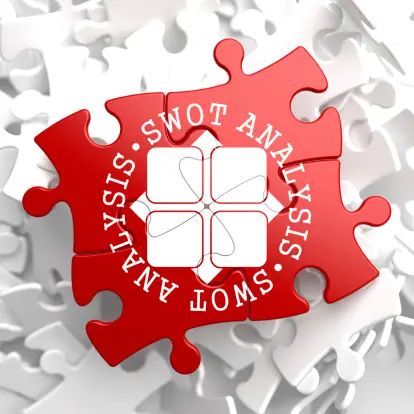SWOT analysis evaluates a company’s competitive position and develops strategic planning. SWOT analysis evaluates internal, external, and future factors.
SWOT analyses is a Business term that help companies, initiatives, and industries assess their strengths and weaknesses. Avoiding preconceptions and focusing on real-world contexts will help the organization’s analysis. It should guide companies, not prescribe.
Key takeaways
SWOT analysis aids strategic planning.
It is identifying core strengths, weaknesses, opportunities, and threats yields fact-based analysis, fresh perspectives, and new ideas.
SWOT analyses include internal (company strengths and weaknesses) and external (opportunities and threats) factors influencing decisions.
SWOT analysis works best when diverse voices within an organization can provide realistic data points rather than prescribed messaging.
SWOT analysis results are often combined to support a business goal or decision.
How to Use the SWOT Analysis
SWOT analysis evaluates a company’s performance, competition, risk, and potential.
The technique uses internal and external data to steer businesses toward successful strategies and away from unsuccessful ones. They can also ask independent SWOT analysts, investors, or competitors if a company, product line, or industry is strong or weak and why.

What’s in a SWOT Analysis?
Every SWOT analysis includes these four categories. A SWOT analysis is incomplete without these elements:
Strengths
Strengths include a strong brand, loyal customers, a strong balance sheet, unique technology, and more. Hedge funds may have a market-beating trading strategy. It must then decide how to use those results to attract investors.
Weaknesses
Weaknesses hold an organization back. The business must improve its brand, turnover, debt, supply chain, and capital to stay competitive.
Opportunities
Opportunities are external factors that could give a company an edge. If a country lowers tariffs, a car manufacturer can export to a new market, increasing sales and market share.
Threats
Threats can harm an organization. Droughts can ruin wheat crops, threatening wheat producers. Material costs, competition, and labor shortages are other threats. So on.
SWOT Table
SWOT analysts divide a square into four quadrants, each devoted to a SWOT element. This graphic shows the company’s position. Although not all points under a heading are equally important, they should all provide critical insights into the balance of opportunities and threats, advantages and disadvantages, etc.
SWOT tables typically list internal factors on top and external factors on the bottom. The left side of the table has positive/favorable items, while the right side has negative/concerning items.

SWOT Analysis
SWOT analysis has several steps with actionable items before and after analyzing the four components. SWOT analyses typically follow these steps.
Step 1: Set Goals
SWOT analyses can be broad, but focusing on an objective will likely yield more value. A SWOT analysis may only consider launching a new product. A company will know what to aim for with an objective. This SWOT analysis should help decide if the product should be introduced.
2: Gather Resources
A company may need different data sets for different SWOT analysis tables. A company should assess its data, limitations, and external sources.
A company needs data and the right people to analyze it. Some staff are more connected to external forces, while others in manufacturing or sales may know more about internal forces. Broad perspectives lead to diverse, value-added contributions.
3: Compile Ideas
The SWOT analysis team should list ideas for each of the four components. See the table below for group-specific questions.
Internal Factors
SWOT analysis strengths and weaknesses can be gleaned from company events. Internal factors include financial and human resources, brand name assets, and operational efficiencies.
Internal factors may include:
What works?
Our greatest strength?
Our critics?
Our weakest product lines?
External Factors
External factors affect a company’s success as much as internal ones. Monetary policies, market changes, and supplier access can be used to identify opportunities and weaknesses.
List external factors:
Strengths
- Our advantage?
- What’s available?
- What’s selling?
Weaknesses
- Where can we improve?
- Underperforming products?
- Where are resources lacking?
Opportunities
- What’s new?
- Can we expand operations?
- Can we test new segments?
Threats
- What regulations change?
- Competitors’ actions?
- Consumer habits are changing.
This step may be a “white-boarding” or “sticky note” session. Participants should share their thoughts since there is no right or wrong answer. In the meantime, brainstorm as many ideas as possible to inspire others.
4: Refine Results
After categorizing ideas, clean them up. A company can prioritize the best ideas and most significant risks by refining everyone’s thoughts. At this stage, analysis participants may debate priorities and bring in upper management.
5: Strategize
Create a strategic plan after ranking strengths, weaknesses, opportunities, and threats. The analysis team synthesizes each category’s bulleted list of items to guide the original objective.
The company debating whether to release a new product may have found that it is the market leader for its existing product and can expand to new markets. Increased material costs, strained distribution lines, staff shortages, and unpredictable product demand may outweigh the strengths and opportunities. The analysis team plans to revisit the decision in six months to lower costs and clarify market demand.
SWOT analysis helps you identify business challenges and opportunities. It is one of many methods, not a prescription.
SWOT Benefits
SWOT analysis will only answer some of a company’s big questions. SWOT analyses simplify strategic decision-making.
SWOT analysis simplifies complex issues. When making a complex decision, there may be too much data and relevant points to consider. A SWOT analysis that pares down ideas and ranks bullets by importance will simplify a significant, potentially overwhelming problem.
SWOT analysis needs external consideration. Too often, companies make decisions based on internal factors. However, external factors can affect business decisions. SWOT analyses cover internal and external factors.
SWOT analysis can solve most business problems; So it can be so much useful for business ideas based on problem to solve. Organizations, teams, and individuals are analyzed. It can analyze a full product line, brand changes, geographical expansion, or acquisition. SWOT analysis is multipurpose.
SWOT analysis uses multiple data sources. A company will likely use internal data for strengths and weaknesses. The company will need external data on broad markets, competitors, and macroeconomic forces for opportunities and threats. A good SWOT analysis uses multiple sources rather than one biased one.
SWOT analyses may be affordable. Some SWOT reports could be more technical, so many staff members can help prepare them without training or outside help.
SWOT Example
A 2015 Value Line SWOT analysis of The Coca-Cola Company highlighted its global brand name, vast distribution network, and emerging market opportunities. However, foreign currency fluctuations, growing public interest in “healthy” beverages, and competition from healthy beverage providers were weaknesses and threats.
Value Line’s SWOT analysis raised questions about Coca-Cola’s strategy but also noted that the company “will probably remain a top-tier beverage provider” that offered conservative investors “a reliable source of income and a bit of capital gains exposure.”
Coca-Cola still ranks 6th worldwide five years after Value Line SWOT analysis. After five years, Coca-Cola’s (KO) shares have increased by over 60%.
A fictitious organic smoothie company illustrates a SWOT analysis. SWOT analysis helped it understand its smoothie market competition and how to improve. This analysis revealed its strengths: good ingredient sourcing, personalized customer service, and strong supplier relationships. It found product diversification, high turnover, and outdated equipment as weaknesses.
It saw opportunities in emerging technology, untapped demographics, and a cultural shift toward healthy living. Threats included crop damage from a winter freeze, a global pandemic, and supply chain issues. The company leveraged its strengths and external opportunities to eliminate threats and strengthen its weaknesses using SWOT analysis and other planning methods.
SWOT Analysis?
SWOT (strengths, weaknesses, opportunities, and threats) analysis helps companies set strategic goals by identifying and analyzing internal and external strengths and weaknesses. Companies use SWOT analyses. SWOT analysis can also be used for self-improvement.
SWOT Analysis Example?
Home Depot created a balanced SWOT analysis of its internal strengths and weaknesses and external factors threatening its market position and growth strategy. Its strengths were high-quality customer service, brand recognition, and positive supplier relationships. At the same time, its weaknesses were a constrained supply chain, dependence on the U.S. market, and a replicable business model.
Home Depot’s threats—close competitors, substitutes, and the U.S. market—were related to its weaknesses. This study and others showed that expanding its supply chain and global footprint would boost growth.
SWOT Analysis: 4 Steps?
SWOT means strengths, weaknesses, opportunities, and threats. Two steps can analyze these four aspects. First, a company evaluates its internal strengths and weaknesses. A company then assesses external factors affecting its business. These external factors may offer or threaten operations.
Writing a SWOT Analysis: How?
SWOT analysis involves assessing a company’s strengths, weaknesses, opportunities, and threats. Start by listing questions for each element. The questions guide SWOT analysis and list balance. The SWOT framework is usually a 4-cell table with quadrants for each element. Opportunities and threats follow strengths and weaknesses.
SWOT Analysis—Why?
A SWOT analysis helps a company strategically identify strengths and weaknesses. SWOT analysis also examines a company’s weaknesses. With this information, a company can make better decisions to preserve its strengths, capitalize on its weaknesses, mitigate risk, and plan for future events that may harm it.
SWOT Analysis: How-To with Table and Example
Business-strategy meetings benefit from SWOT analyses. Discussing the company’s strengths and weaknesses, opportunities and threats, and ideas with everyone in the room is powerful. During the session, your SWOT analysis may change to include factors you didn’t know about.
SWOTs can be used for business strategy sessions or departments like marketing, production, or sales. Before committing, you can see how the SWOT analysis strategy will affect the segments below. You can also use a segment-specific SWOT analysis to inform an overall SWOT analysis.
SWOT has its drawbacks. It should be used with other business planning methods. Each category point is prioritized differently. SWOT ignores weight differences. Thus, another planning method is needed to analyze further.




